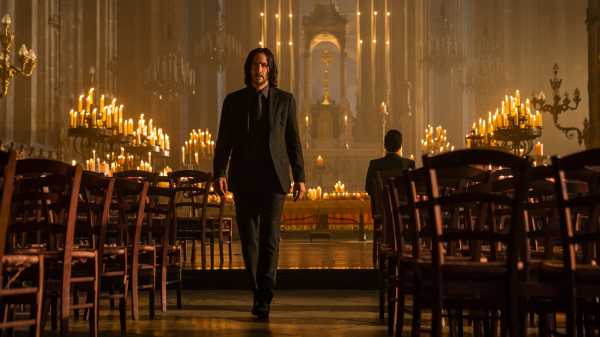
“John Wick: Chapter 4” is by far the best of the four films starring Keanu Reeves as the eponymous hit man, the first of the cycle that I’d recommend—albeit with an asterisk. The new film (which opens Friday) has many of the same problems as its predecessors; although these problems are interesting, they’re far more fun to contemplate in the rearview mirror of thought than in the real-time forward motion of viewing. But something happens, fairly late in the game, that converts the film’s merely technical displays of bloody murder into something suspenseful and romantic, if no less silly. The details are too good to give away, but there’s no harm and much pleasure in considering how the movie climbs, slowly but surely, to that light-headed summit.
One of the curiosities of the John Wick series is that, as an entirely original creation dependent on no prior properties, it has nonetheless given rise to an alluring and self-perpetuating mythology of its own. The premise of Wickworld is cleverly paranoiac, built around the tentacular connections between the crude underworld of contract killers and the shadowy overlords who keep them in action. That wicked authority is called the High Table; it dispenses orders to kill on pain of being killed, ratifies contracts for murder, and brokers the deals for bounty hunters. It commands John to kill, and it sets him up to be killed, but it also sets the tone of the movie. The High Table exemplifies a super-élite of secret societies with elaborate rites, deeply rooted aristocracies, a flaunting of mind-bending wealth, and the executive ruthlessness of a transnational shadow government that has the power to wreak havoc in public with impunity.
It also has the power of information—an enormous database on its registered killers (it apparently goes back centuries) and a terrifyingly comprehensive surveillance network that tracks the hunters and the hunted during their mortal maneuvers and discloses their whereabouts to devastating effect. Its agents hide in plain sight at, for instance, a hotel called the New York Continental, in Manhattan’s financial district. (Delmonico’s plays the role of the hotel.) Its stern manager, Winston (Ian McShane), is John’s handler, and is aided by his discerning and tight-lipped concierge (played by Lance Reddick, who died on March 17th). Another High Table agent on John’s team, the Bowery King (Laurence Fishburne), disguises his crew of spies as unhoused people in a shelter that he runs.
The High Table itself reveals its enduring traditions in the anachronistic equipment and furnishings of its central intelligence office (complete with card files, blackboards, rubber stamps, and switchboards). The venerable sect of hired killers can trace its lineage to a few authorized families, an aristocracy of blood (pun intended) that pulls the death dealers out of the grubby streets and endows their gruesome trade with a faux dignity. Their rigorous code of conduct dominates the movie’s, and the franchise’s, over-all tone and import: the intricate set of seemingly nonsensical rules plays the role of military discipline and order, but it also signifies, with a politicized wink at the rites and manners of high society, the implacable law of violence, which pretensions to refinement both embody and conceal.
“Chapter 4” takes off from the third installment, which concluded with John killing a High Table assassin at the New York Continental, with Winston’s help, and then teaming up with the Bowery King to fight against the High Table. At the start of “Chapter 4,” the King gets John suited up for battle, and the High Table takes devastating revenge against Winston for helping John—for starters, Winston is excommunicated, and the hotel is demolished. John heads to Morocco (the actual location is in Jordan) to dispatch a High Table overlord called the Elder (George Georgiou) and his minions, then goes to Osaka—to the Osaka Continental hotel, another High Table base—where he learns from its manager (Hiroyuki Sanada), who is his friend, what happened to Winston and the New York hotel. John vows to “kill them all.”
But the manager’s daughter, Akira (Rina Sawayama), who is also John’s friend, wishes he hadn’t come. There’s a contract on John for having killed High Table notables, and Akira is well aware that any place he sets foot is a target, including her father’s hotel. The assassins pursuing him there include a bounty hunter called Mr. Nobody (Shamier Anderson), who shows up with his beloved dog (a cheeky reference back to the premise of the first John Wick movie), and a nasty nebbish called Chidi (Marko Zaror). There’s also a remarkable blind assassin named Caine (Donnie Yen), who has been dispatched by a High Table potentate called the Marquis de Gramont (Bill Skarsgård), an effete and sadistic nobleman who has laid waste to the New York hotel and threatened to kill Caine’s daughter unless Caine kills John.
Yet John, for all his seething lust for revenge, is burdened—he is (to quote Charlie Chaplin’s parody of Hollywood violence in “A King in New York”) a killer with a soul. The very premise of “Chapter 4” evinces sequel fatigue. John Wick wants out. Reeves may well enjoy the role, but he convincingly portrays John’s weariness bordering on exasperation at the absurdity of living under the orders—and in the crosshairs—of the implacable High Table. Even though he shoots and stabs and even nunchucks his way out of the Osaka Continental, leaving a trail of bodies and blood behind, he can’t kill his way out of his indenture to the High Table or its pursuit of him.
What happens in Osaka doesn’t stay in Osaka, and neither does John. He flits to New York, where Winston advises him to duel the Marquis for his freedom, and then to Berlin, where, in a series of set pieces ranging from the sententious to the ridiculous, he has to do some more killing in order to be deemed duel-worthy. What results is a grisly form of multidimensional chess, in which John’s enemies also target one another in order to keep for themselves the privilege of killing John, and in which John allies himself, according to the demands of the moment, with one or another of his prospective killers.
Much of the movie’s delight is in its details, many of them gory (a little trick with a knife that the Marquis pulls on Mr. Nobody), others merely menacing (John’s surprise encounter on an eerily empty subway car), some location-dependent (a brutalist night club with a waterlogged dance floor), and some design-based (including a deck of cards made of glass, and a picturesque molten-gold method for branding flesh). Some of these flourishes nod toward the breezy suaveness in the face of danger that marks the best of the early 007 films. Here, though, the stakes are lowered beneath the absurdity line by the relentless mayhem, which is at once cartoonish and mostly humorless. That’s why, as Caine, Donnie Yen nearly steals the film. His humor is as sly as it is insolent (as when he eats a snack between killings), and his comedic gestures are as tiny and deft as his action maneuvers, which are so fast as to border on sleight of hand.
The comic relief is welcome, but it’s never so extreme or so self-aware as to threaten the grim earnestness and grotesque exaggerations of the violence. (With a little more self-awareness, the movie would have a place in the body-horror genre.) A recent report places John’s estimated body count throughout the series at four hundred and fifty. I’m not sure how many of them pile up in “Chapter 4,” but, assuming a rough average of a hundred and twelve, the killings are (as in the first three chapters) classist and trivializing. Only a few of John’s opponents have names, identities, and personalities; most are woefully anonymous, dispatched into oblivion by John with neither a name nor a story, with nothing but the misfortune to square off against him. They are mere fodder for John’s deathcraft, their heads vaporizing in pink mist inside their battle helmets, their bodies catching fire from his incendiary weaponry, their blood spurting fountain-like from slash wounds.
The director, Chad Stahelski, works these elaborate fights and their flimsy killings with flashy but insignificant embellishments (such as filming an indoor battle royal from overhead, as if by drone). He displays little imagination regarding the characters’ activity, or even existence, outside the realm of combat. The many unnamed victims’ mechanical dispatch is a logical function of the franchise’s basic premise: that John (like his co-starring killers) is a member of a breed apart, dealing and eluding death with aplomb but never enduring the petty cares that go with the job. Does John Wick have a passport? He may be superheroic with firearms, fists, and whatever other weapons are within arm’s reach, but he doesn’t fly like Superman. Does he go first class or economy? What does he say when he reaches passport control and is asked, “Business or pleasure?” Does he have an array of forged documents, under a variety of pseudonyms and nationalities, that he switches around to fit his sense of the circumstances? With all the killing that he’s done, has he never come under suspicion? Does he ever worry about it? His exploits may be extraordinary, but they’re nonetheless dependent upon ordinary, unseen necessities. (If, as he leaves Osaka for New York, he’s as filled with regrets as he’d have one believe, spending sixteen hours sandwiched in a middle seat between two snorers would be an apt setting to ponder where he went wrong.) Does he listen to music, does he read a book, does he have a favorite food?
Most of “Chapter 4” is an amusingly punctuated slog. It’s distinguished from its predecessors by the starkly drawn yet complex lines of conflict. The promised duel, ingeniously plotted and cleverly staged, depends on a droll race against the clock—one that gives new meaning to the notion of fighting one’s way through traffic—and a long staircase that becomes a virtual agent of destiny. In short, the last half hour or so of the movie’s nearly three-hour span is giddily intense, swoony, swashbuckling, and sensational yet superficial fun. Right after I saw the movie, I couldn’t stop talking about that ending. It makes the rest of the movie worth sitting through. ♦
Sourse: newyorker.com






